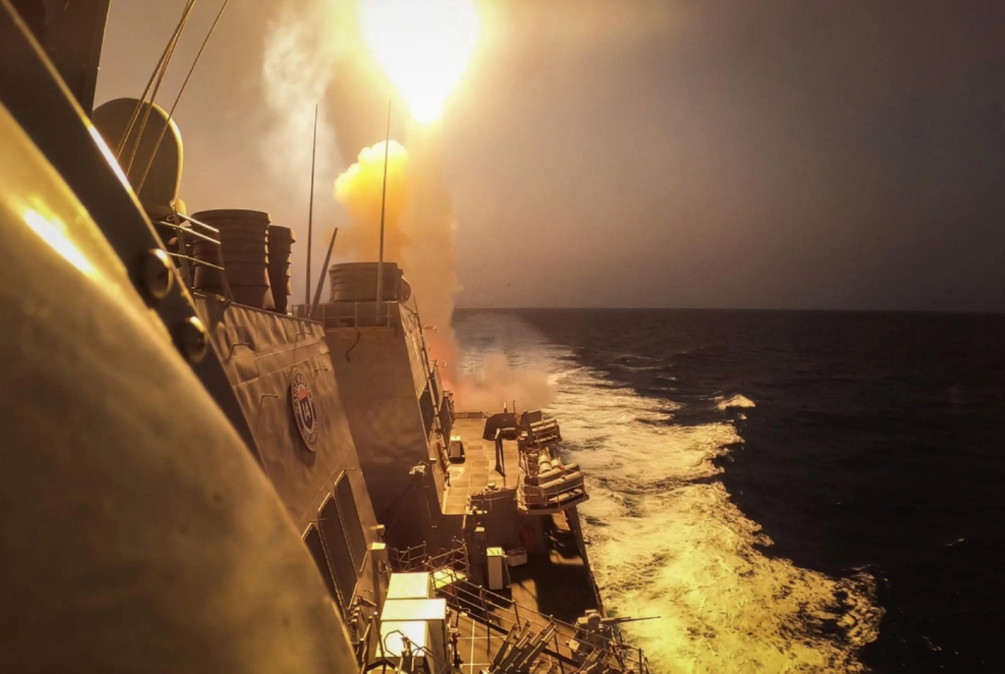Naval information forces taking rapid lessons from Red Sea attacks

SAN DIEGO, Calif. — The Navy’s information warfare organization is learning lessons from operations in the Red Sea, seeing them as an enduring challenge.
“We need to increase the commander’s decision space. The battlespace awareness piece and the non-kinetic effects piece for integrated fires in the end. We did bring back lessons learned,” Elizabeth Nashold, deputy commander of Naval Information Forces, said at the annual WEST conference this week. “Through our warfighting development center, [Naval Information Warfighting Development Center], we improved our [tactics, techniques and producers] for the things that IW is responsible for to feed back out to the fleet. Yes, we were increasing our proficiency every day.”
NAVIFOR is responsible for providing trained information forces and equipment to the Navy.
Since October, the USS Carney has been in the Red Sea combating one-way drones launched from Yemen by the Houthis, a group backed by Iran that has controlled portions of Yemen, including the capital, since 2014.
The Houthis said those attacks have been in response to the U.S. support for Israel in the wake of Hamas’ Oct. 7, 2023, attack. Israel has been waging a months-long offensive in Gaza to oust Hamas.
From an information warfare standpoint, Nashold said officials are looking at non-kinetic ways to disrupt what the Houthis and others could be throwing at American. forces. The term “non-kinetic,” in U.S. military parlance, generally refers to capabilities that don’t use traditional types of ammunition against their targets. Examples include electronic warfare, cyber, directed energy, information tools and others.
“We’re looking for anything that can deny, degrade, deceive, destroy, from a non-kinetic effect perspective, so that we can save the ammunition and the ordnance that we have. At this classification level, we do have those capabilities and we are working to improve TTPs based on lessons learned going on right now,” she said.
Nashold noted that the Carney was ready on day one. In order to shoot down the missiles and drones launched by the Houthis, it had to exercise the three pillars of information warfare: battlespace awareness, assured command and control, and integrated fires.
For battlespace awareness, the ship had intelligence regarding the Houthi rhetoric about what they intended to do and when they would do it. They also had sensors to detect the launch of missiles and unmanned aerial vehicles.
The way the commander was able to engage the targets was enabled by assured command and control, she said.
“We had all the communications in place. The entire strike group knew what was going on. And that’s because of assured command and control,” Nashold added.
When it came to integrated fires, Nashold noted the ship employed non-kinetic effects to aid in the launch of kinetic weapons to support the response.
“We had IW support across all domains: meteorology, oceanography, intelligence, cryptology, space, cyber and electronic warfare. All of those capabilities were essential to the Carney success,” she said.
The Navy’s “top gun” school for information warfare — which specializes in doctrine, tactics, techniques, procedures, capabilities and building specialized information warfare instructors for the fleet — is taking lessons from the engagements and adopting new concepts.
“We can really rapidly understand the performance of our IW systems forward and update the TTP that were employed. And then we will … better posture those forces to respond to threats,” Capt. Bryan Braswell, commander of the Naval Information Warfighting Development Center, said at the conference.
Braswell said it’s a team effort across other warfighting development centers because it’s not just information warfare equipment that is being used to thwart Houthi capabilities. They are able to rapidly take in what is happening operationally and get new lessons back out to U.S. forces.
“We do have a decent level of understanding, even if it’s at a rudimentary level about even some very basic system performance parameters,” he said. “We could have been more ready … but I feel that we’re very ready now in a repeatable way, to learn day by day by day from that.”
He added that he views the ability to quickly take in lessons and get them back out to the fleet as a repeatable process, especially given the ongoing Houthi threat, the possibility of other actors adopting those tactics, or the emergence of a new threat that the force hasn’t encountered yet.
It’s “repeatable in terms of being able to learn and then make that extensible to other threats that may be in the same threat category or class that may matter in another part of the world [and] … repeatable in terms of being ready as a headquarters element as the warfighting development center. For that to happen on any given day and then be able to put a team quickly together to quickly be able to partner with — whether it’s a systems command or a WDC … to be able to do that very quickly and then be able to move out” is key, he said.
Nashold said she sees this as an enduring challenge. In other words, it’s not just about digesting lessons to address the current situation in the Red Sea, but rather a long-term problem the force will have to adjust its tactics against.
“It’s enduring. And the reason I say it’s enduring as part of being able to do that is to make sure that we have the organization and governance to do it,” she said. “It’s more of an enduring function is that we have the governance in place to keep doing it and having, once we get intelligence, feed it back, feed it into our TTPs, see what the adversary is doing, see how we can counter it and then just keep iterating on it.”



